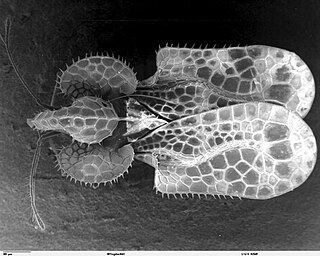
The Cimicomorpha are an infraorder of insects in the order Hemiptera, the true bugs. The rostrum and other morphology of all members apparently is adapted to feeding on animals as their prey or hosts. Members include bed bugs, bat bugs, assassin bugs, and pirate bugs.

The Emesinae, or thread-legged bugs, are a subfamily of the Reduviidae. They are conspicuously different from the other reduviids by their very slender body form. They are stalking, predatory insects that can be collected on palm fronds, cliffs, spider webbing, or near lights at night. They walk on their mid and hind legs; the front pair is raptorial. Some groups specialize on spiders. Very little is known about emesines except that many species are found in the tropics. Pedro Wygodzinsky wrote the most recent revision of this group.
Ghilianella phasma is a species of assassin bug in the subfamily Emesinae. It is found on the Indian subcontinent and in Myanmar. There is some debate about whether this species may belong in the genus Schidium. William Lucas Distant placed the species in Ghilianella but Ernst Evald Bergroth and Pedro Wygodzinsky moved it to Schidium. In his 1990 work of the Reduviidae of the world, Moldonado doubted the Schidium placement.

Ploiaria is a cosmopolitan genus of thread-legged bugs (Emesinae). There are presently about 130 described species.

Stenolemus is a genus of thread-legged bug (Emesinae). Species of this genus are noted for preying on spiders.
Gardena is a genus of thread-legged bugs in the subfamily Emesinae. It is the second-largest genus in the tribe Emesini. Presently there are 46 described species.
The Leistarchini is a tribe of thread-legged bugs.
The Metapterini are a tribe of thread-legged bugs, assassin bugs of subfamily Emesinae.

Emesopsis is a genus of tropical bugs (Heteroptera) from the family Reduviidae. There are at least 22 described species, of which one, E. nubila, also occurs in southern Europe.
Bagauda is a genus of thread-legged bug in the Emesinae. 18 species are currently known. Many of the species of this genus are associated with caves, some exclusively so. Bagauda is synonymous with the genus Pleias Kirkaldy, 1901, but Bagauda has become more widely used. The genus is restricted to Old World tropics.
Chinemesa is a little-known genus of thread-legged bug (Emesinae) apparently endemic to Borneo. Only four species have been described and the three described by Wygodzinsky in 1966 have not been observed since.
Polauchenia is a genus of thread-legged bug (Emesinae). Only five species have been described.
Phasmatocoris is a little-known genus of thread-legged bug (Emesinae). Fourteen species have been described, including 3 from Colombia.

Empicoris is a cosmopolitan genus of thread-legged bug (Emesinae). Numerous species have been described.
Onychomesa is a little-known genus of thread-legged bug in the subfamily Emesinae. Three species have been described, one from India, Japan, and Taiwan.
The Collartidini is a tribe of thread-legged bugs restricted to Africa, Sri Lanka and Taiwan. Wygodzinsky (1966) proposed that this group is the sister group of the remaining Emesinae.

Ptilocnemus is a genus of feather-legged bugs in the Holoptilinae subfamily. At least 12 species have been described. These species have a specialized gland called a trichome that produces a chemical to attract and paralyze ants.

The Ectrichodiinae are a subfamily of assassin bugs (Reduviidae) known for specializing on millipedes as prey. The group comprises more than 600 species in about 115 genera, making it a fairly large subfamily. The bugs are also known for their aposematic coloration, often brightly colored metallic blue, red, or yellow.
Pseudometapterus is a little-known genus of thread-legged bug in the subfamily Emesinae. Members of the genus occur in North America and usually have wings that are extremely small or absent entirely, though a winged form of P. umbrosus is known from Southern Illinois.
Stenolemoides is a genus of thread-legged bugs in the family Reduviidae. There are at least three described species in Stenolemoides.







